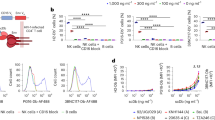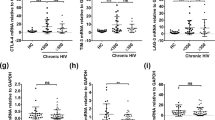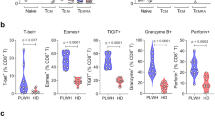Abstract
The viral reservoir is the major hurdle in developing and establishing an HIV cure. Understanding factors affecting the size and decay of this reservoir is crucial for the development of therapeutic strategies. Recent work highlighted that CD8+ T cells are involved in the control of viral replication in ART-treated HIV-1-infected individuals, but how CD8+ T cells sense and restrict the HIV reservoir are not fully understood. Here, we demonstrate that a population of unconventional CD45RA+, PanKIR+, and/or NKG2A+ virtual memory CD8+ T cells (TVM cells), which confer rapid and robust protective immunity against pathogens, plays an important role in restraining the HIV DNA reservoir in HIV-1-infected patients with effective ART. In patients undergoing ART, TVM cells negatively correlate with HIV DNA and positively correlate with circulating IFN-α2 and IL-15. Moreover, TVM cells constitutively express high levels of cytotoxic granule components, including granzyme B, perforin and granulysin, and demonstrate the capability to control HIV replication through both cytolytic and noncytolytic mechanisms. Furthermore, by using an ex vivo system, we showed that HIV reactivation is effectively suppressed by TVM cells through KIR-mediated recognition. This study suggests that TVM cells are a promising target to predict posttreatment virological control and to design immune-based interventions to reduce the reservoir size in ART-treated HIV-1-infected individuals.
This is a preview of subscription content, access via your institution
Access options
Subscribe to this journal
Receive 12 digital issues and online access to articles
$119.00 per year
only $9.92 per issue
Buy this article
- Purchase on Springer Link
- Instant access to full article PDF
Prices may be subject to local taxes which are calculated during checkout




Similar content being viewed by others
References
Volberding, P. A. & Deeks, S. G. Antiretroviral therapy and management of HIV infection. Lancet 376, 49–62 (2010).
Furtado, M. R. et al. Persistence of HIV-1 transcription in peripheral-blood mononuclear cells in patients receiving potent antiretroviral therapy. N. Engl. J. Med. 340, 1614–1622 (1999).
Williams, J. P. et al. HIV-1 DNA predicts disease progression and post-treatment virological control. Elife 3, e03821 (2014).
Graf, E. H. et al. Elite suppressors harbor low levels of integrated HIV DNA and high levels of 2-LTR circular HIV DNA compared to HIV+ patients on and off HAART. PLoS Pathog. 7, e1001300 (2011).
Hocqueloux, L. et al. Long-term immunovirologic control following antiretroviral therapy interruption in patients treated at the time of primary HIV-1 infection. Aids 24, 1598–1601 (2010).
Cromer, D. et al. Modeling of antilatency treatment in HIV: what is the optimal duration of antiretroviral therapy-free HIV remission? J. Virol. 91, e01395–01317 (2017).
Davenport, M. P. et al. Functional cure of HIV: the scale of the challenge. Nat. Rev. Immunol. 19, 45 (2019).
Collins, D. R., Gaiha, G. D. & Walker, B. D. CD8(+) T cells in HIV control, cure and prevention. Nat. Rev. Immunol. (2020). https://doi.org/10.1038/s41577-020-0274-9
Borrow, P., Lewicki, H., Hahn, B. H., Shaw, G. M. & Oldstone, M. Virus-specific CD8+ cytotoxic T-lymphocyte activity associated with control of viremia in primary human immunodeficiency virus type 1 infection. J. Virol. 68, 6103–6110 (1994).
Koup, R. et al. Temporal association of cellular immune responses with the initial control of viremia in primary human immunodeficiency virus type 1 syndrome. J. Virol. 68, 4650–4655 (1994).
Walker, B. D. & Xu, G. Y. Unravelling the mechanisms of durable control of HIV-1. Nat. Rev. Immunol. 13, 487–498 (2013).
Migueles, S. A. et al. Lytic granule loading of CD8+ T cells is required for HIV-infected cell elimination associated with immune control. Immunity 29, 1009–1021 (2008).
Cartwright, E. K. et al. CD8+ lymphocytes are required for maintaining viral suppression in SIV-infected macaques treated with short-term antiretroviral therapy. Immunity 45, 656–668 (2016).
Sáez-Cirión, A. et al. Post-treatment HIV-1 controllers with a long-term virological remission after the interruption of early initiated antiretroviral therapy ANRS VISCONTI Study. PLoS Pathog. 9, e1003211 (2013).
Keating, S. M. et al. Brief Report: HIV antibodies decline during antiretroviral therapy but remain correlated with HIV DNA and HIV-specific T-cell responses. JAIDS J. Acquired Immune Defic. Syndromes 81, 594–599 (2019).
Phillips, R. E. et al. Human immunodeficiency virus genetic variation that can escape cytotoxic T cell recognition. Nature 354, 453 (1991).
Deng, K. et al. Broad CTL response is required to clear latent HIV-1 due to dominance of escape mutations. Nature 517, 381 (2015).
Jones, R. B. et al. A subset of latency-reversing agents expose HIV-infected resting CD4+ T-cells to recognition by cytotoxic T-lymphocytes. PLoS Pathog. 12, e1005545 (2016).
Migueles, S. A. et al. HIV-specific CD8+ T cell proliferation is coupled to perforin expression and is maintained in nonprogressors. Nat. Immunol. 3, 1061 (2002).
Hersperger, A. R. et al. Increased HIV-specific CD8+ T-cell cytotoxic potential in HIV elite controllers is associated with T-bet expression. Blood 117, 3799–3808 (2011).
Hersperger, A. R. et al. Perforin expression directly ex vivo by HIV-specific CD8+ T-cells is a correlate of HIV elite control. PLoS Pathog. 6, e1000917 (2010).
Folkvord, J. M., Armon, C. & Connick, E. Lymphoid follicles are sites of heightened human immunodeficiency virus type 1 (HIV-1) replication and reduced antiretroviral effector mechanisms. AIDS Res. Hum. Retroviruses 21, 363–370 (2005).
Fukazawa, Y. et al. B cell follicle sanctuary permits persistent productive simian immunodeficiency virus infection in elite controllers. Nat. Med. 21, 132 (2015).
Huang, S.-H. et al. Latent HIV reservoirs exhibit inherent resistance to elimination by CD8+ T cells. J. Clin. Investig. 128, 876–889 (2018).
Haluszczak, C. et al. The antigen-specific CD8+ T cell repertoire in unimmunized mice includes memory phenotype cells bearing markers of homeostatic expansion. J. Exp. Med. 206, 435–448 (2009).
White, J. T., Cross, E. W. & Kedl, R. M. Antigen-inexperienced memory CD8+ T cells: where they come from and why we need them. Nat. Rev. Immunol. 17, 391 (2017).
White, J. T. et al. Virtual memory T cells develop and mediate bystander protective immunity in an IL-15-dependent manner. Nat. Commun. 7, 11291 (2016).
Jacomet, F. et al. Evidence for eomesodermin‐expressing innate‐like CD8+ KIR/NKG2A+ T cells in human adults and cord blood samples. Eur. J. Immunol. 45, 1926–1933 (2015).
Quinn, K. M. et al. Age-related decline in primary CD8+ T cell responses is associated with the development of senescence in virtual memory CD8+ T cells. Cell Rep. 23, 3512–3524 (2018).
Hussain, T. & Quinn, K. M. Similar but different: virtual memory CD8 T cells as a memory‐like cell population. Immunol. Cell Biol. 97, 675–684 (2019).
Ghanem, E. N. B., Nelson, C. C. & D’Orazio, S. E. T cell-intrinsic factors contribute to the differential ability of CD8+ T cells to rapidly secrete IFN-γ in the absence of antigen. J. Immunol. 186, 1703–1712 (2011).
Lanzer, K. G., Cookenham, T., Reiley, W. W. & Blackman, M. A. Virtual memory cells make a major contribution to the response of aged influenza-naïve mice to influenza virus infection. Immun. Ageing 15, 17 (2018).
Rolot, M. et al. Helminth-induced IL-4 expands bystander memory CD8+ T cells for early control of viral infection. Nat. Commun. 9, 4516 (2018).
Lin, J. et al. Virtual memory CD8 T cells expanded by helminth infection confer broad protection against bacterial infection. Mucosal Immunol. 12, 258 (2019).
Barbarin, A. et al. Phenotype of NK-like CD8(+) T cells with innate features in humans and their relevance in cancer diseases. Front. Immunol. 8, 316 (2017).
Swanson, B. J., Murakami, M., Mitchell, T. C., Kappler, J. & Marrack, P. RANTES production by memory phenotype T cells is controlled by a posttranscriptional, TCR-dependent process. Immunity 17, 605–615 (2002).
Shan, L. et al. Stimulation of HIV-1-specific cytolytic T lymphocytes facilitates elimination of latent viral reservoir after virus reactivation. Immunity 36, 491–501 (2012).
Helleberg, M. et al. Course and clinical significance of CD8+ T-cell counts in a large cohort of HIV-infected individuals. J. Infect. Dis. 211, 1726–1734 (2014).
Zhang, J.-Y. et al. PD-1 up-regulation is correlated with HIV-specific memory CD8+ T-cell exhaustion in typical progressors but not in long-term nonprogressors. Blood 109, 4671–4678 (2007).
Chun, T.-W. et al. Suppression of HIV replication in the resting CD4+ T cell reservoir by autologous CD8+ T cells: implications for the development of therapeutic strategies. Proc. Natl Acad. Sci. USA 98, 253–258 (2001).
McBrien, J. B., Kumar, N. A. & Silvestri, G. Mechanisms of CD8+ T cell‐mediated suppression of HIV/SIV replication. Eur. J. Immunol. 48, 898–914 (2018).
Freel, S. A. et al. Initial HIV-1 antigen-specific CD8+ T cells in acute HIV-1 infection inhibit transmitted/founder virus replication. J. Virol. 86, 6835–6846 (2012).
Martinet, V. et al. Type I interferons regulate eomesodermin expression and the development of unconventional memory CD8+ T cells. Nat. Commun. 6, 7089 (2015).
Renkema, K. R. et al. IL-4 sensitivity shapes the peripheral CD8+ T cell pool and response to infection. J. Exp. Med. 213, 1319–1329 (2016).
Cardozo, E. F., Apetrei, C., Pandrea, I. & Ribeiro, R. M. The dynamics of simian immunodeficiency virus after depletion of CD8+ cells. Immunological Rev. 285, 26–37 (2018).
Jameson, S. C., Lee, Y. J. & Hogquist, K. A. in Advances in immunology Vol. 126, 173–213 (Elsevier, 2015).
Arosa, F. A. On the origin and function of human NK-like Cd8+ T cells: charting new territories. Front. Immunol. 8, 1588 (2017).
Prajapati, K., Perez, C., Rojas, L. B. P., Burke, B. & Guevara-Patino, J. A. Functions of NKG2D in CD8(+) T cells: an opportunity for immunotherapy. Cell. Mol. Immunol. 15, 470–479 (2018).
Balin, S. J. et al. Human antimicrobial cytotoxic T lymphocytes, defined by NK receptors and antimicrobial proteins, kill intracellular bacteria. Sci. Immunol. 3, eaat7668 (2018).
Collins, K. L., Chen, B. K., Kalams, S. A., Walker, B. D. & Baltimore, D. HIV-1 Nef protein protects infected primary cells against killing by cytotoxic T lymphocytes. Nature 391, 397 (1998).
Boelen, L. et al. Inhibitory killer cell immunoglobulin-like receptors strengthen CD8+ T cell–mediated control of HIV-1, HCV, and HTLV-1. Sci. Immunol. 3, eaao2892 (2018).
Ramsuran, V. et al. Elevated HLA-A expression impairs HIV control through inhibition of NKG2A-expressing cells. Science 359, 86–90 (2018).
Bashirova, A. A., Thomas, R. & Carrington, M. HLA/KIR restraint of HIV: surviving the fittest. Annu. Rev. Immunol. 29, 295–317 (2011).
Study, T. I. H. C. The major genetic determinants of HIV-1 control affect HLA class I peptide presentation. Science 330, 1551 (2010).
Carrington, M. et al. HLA and HIV-1: heterozygote advantage and B* 35-Cw* 04 disadvantage. Science 283, 1748–1752 (1999).
Košmrlj, A. et al. Effects of thymic selection of the T-cell repertoire on HLA class I-associated control of HIV infection. Nature 465, 350 (2010).
Goulder, P. & Deeks, S. G. HIV control: Is getting there the same as staying there? PLoS Pathog. 14, e1007222 (2018).
Sneller, M. C. et al. A randomized controlled safety/efficacy trial of therapeutic vaccination in HIV-infected individuals who initiated antiretroviral therapy early in infection. Sci. Transl. Med. 9, eaan8848 (2017).
Truckenbrod, E. N. & Jameson, S. C. The virtuous self‐tolerance of virtual memory T cells. EMBO J. 37, e99883 (2018).
Drobek, A. et al. Strong homeostatic TCR signals induce formation of self‐tolerant virtual memory CD8 T cells. EMBO J. 37, e98518 (2018).
Ho, Y.-C. et al. Replication-competent noninduced proviruses in the latent reservoir increase barrier to HIV-1 cure. Cell 155, 540–551 (2013).
Wong, J. K. & Yukl, S. A. Tissue reservoirs of HIV. Curr. Opin. HIV AIDS 11, 362 (2016).
Sun, H., Sun, C., Xiao, W. & Sun, R. Tissue-resident lymphocytes: from adaptive to innate immunity. Cell. Mol. Immunol. 16, 205–215 (2019).
Acknowledgements
We thank Chunbao Zhou and Jinhong Yuan (The Fifth Medical Center of the PLA General Hospital) for their technical support with flow cytometry analysis. This study was supported by the Innovation Groups of the National Natural Science Foundation of China (grant no. 81721002), the National Science and Technology Major Project (grant no. 2018ZX10302104-002) and National Natural Science Foundation of China (grant nos. 81901617 and 81772185).
Author information
Authors and Affiliations
Contributions
F.W. and C.Z. conceived the study and wrote the paper with J.J. C.Z., J.J., and H.H. designed and performed most experiments and analyzed the data. The clinical samples and data were contributed by H.H., L.H., Z.X., and G.Y. M.Z., J.L., and W.H. performed flow cytometry on HIV samples. M.S., Y.J., X.F., and J.S. contributed to scientific planning. Intellectual input was provided by all authors.
Corresponding authors
Ethics declarations
Competing interests
The authors declare no competing interests.
Rights and permissions
About this article
Cite this article
Jin, JH., Huang, HH., Zhou, MJ. et al. Virtual memory CD8+ T cells restrain the viral reservoir in HIV-1-infected patients with antiretroviral therapy through derepressing KIR-mediated inhibition. Cell Mol Immunol 17, 1257–1265 (2020). https://doi.org/10.1038/s41423-020-0408-9
Received:
Accepted:
Published:
Issue Date:
DOI: https://doi.org/10.1038/s41423-020-0408-9
Keywords
This article is cited by
-
A virtual memory CD8+ T cell-originated subset causes alopecia areata through innate-like cytotoxicity
Nature Immunology (2023)
-
Innate receptors modulating adaptive T cell responses: KIR-HLA interactions and T cell-mediated control of chronic viral infections
Immunogenetics (2023)
-
Elevated glutamate impedes anti-HIV-1 CD8 + T cell responses in HIV-1-infected individuals on antiretroviral therapy
Communications Biology (2023)
-
Influenza vaccination reveals sex dimorphic imprints of prior mild COVID-19
Nature (2023)
-
Revisiting the role of human memory CD8+ T cells in immune surveillance
Cellular & Molecular Immunology (2022)



